
Carbon footprint is an estimate of the climate change impact of activity – for example producing one kilogram of aquaculture feed. Typically, a carbon footprint is calculated by estimating not just the CO2 emissions that the activity in question causes, but also factors in emissions of other greenhouse gases (such as methane and nitrous oxide) and in some cases other types of climate impacts as well, for example the effect of deforestation. For simplicity, all these impacts are added together and expressed as a single number in terms of carbon dioxide equivalent (CO2e): the amount of CO2 that would create the same amount of warming.
The true carbon footprint of one kilogram of aquaculture feed includes not only the direct emissions resulting from the manufacturing process and the transportation of the feed to the farm. It also includes a whole host of indirect emissions, such as those caused by growing the crops used in the feed, processing of feed ingredients, mining activities, production of vitamins, transport of the raw materials and so on. These are just a few of the processes involved. If you think about it, tracing back all the things that have to happen to make that feed leads to nearly an infinite number of pathways. In order to reduce the carbon footprint, we must look for reductions along the whole value chain.

Next
6. The footprint of our operations
As a global leader in the supply of fish and shrimp feeds, Skretting contributes to the aquaculture industry’s sustainable progress through the provision of feeds that have been formulated from responsibly-sourced raw materials.
